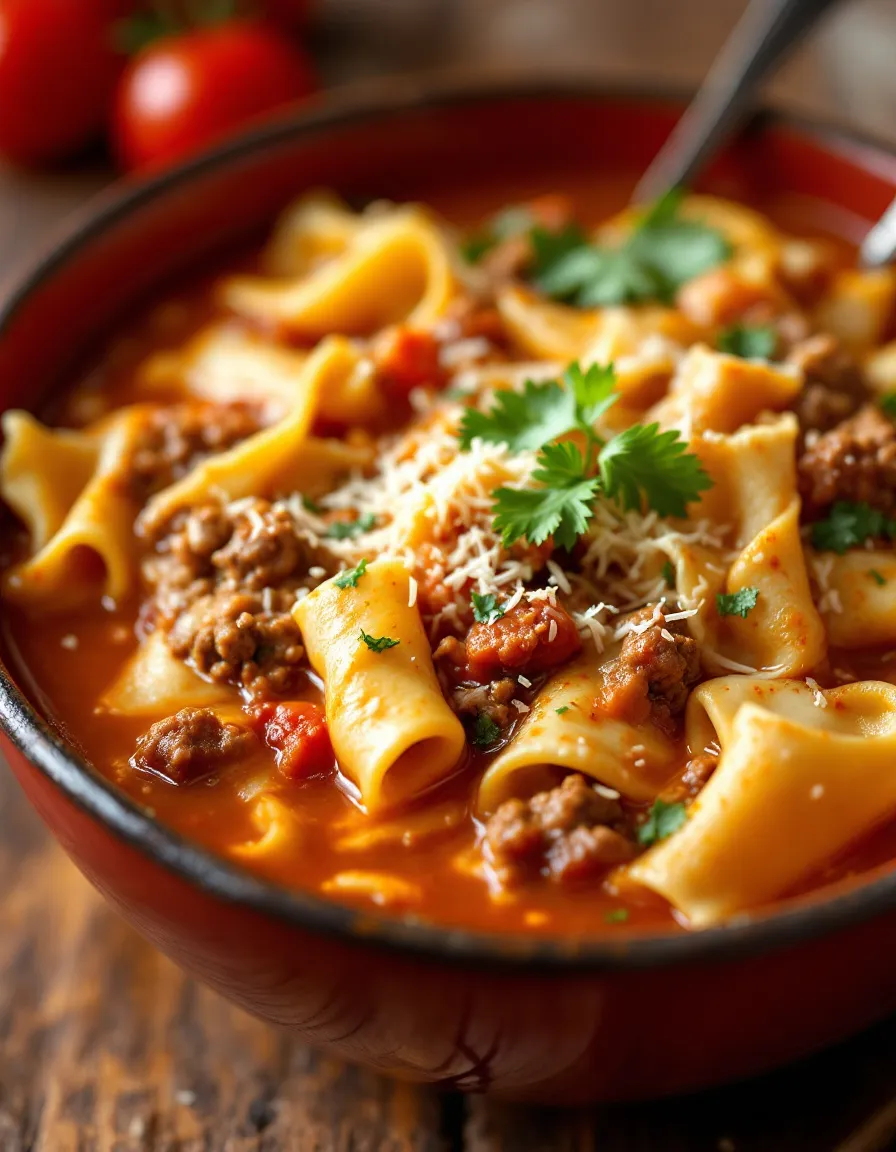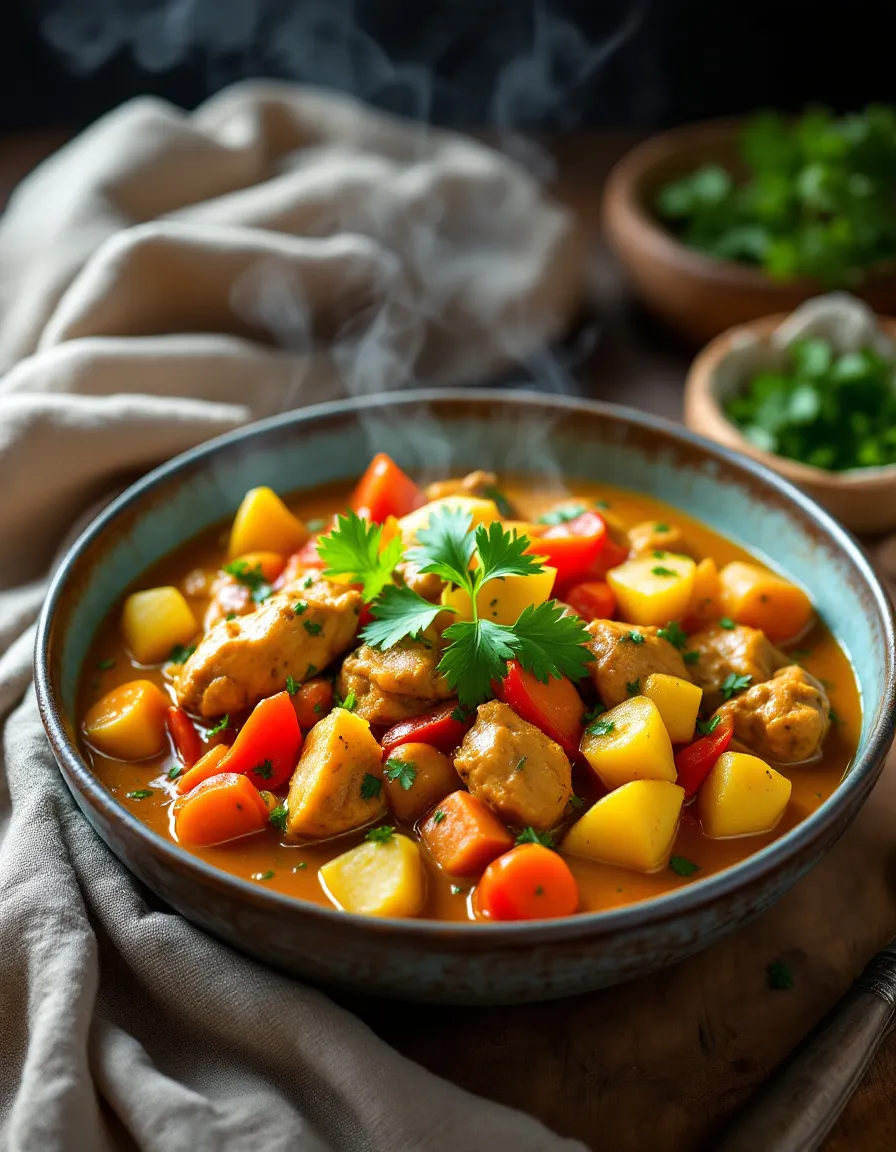Lasagna Soup: A Comforting Twist on a Classic
Lasagna Soup is a heartwarming dish that combines the rich flavors of classic lasagna in a cozy, soup format. It’s a dish that’s perfect for chilly evenings, offering a delightful medley of savory basil-tinged tomatoes, creamy ricotta, and delectable pasta. Imagine a steaming bowl of this comforting soup, where every spoonful captures the essence of traditional lasagna but with added warmth and comfort. Whether you’re cooking for yourself or for friends and family, this soup will surely satisfy everyone’s cravings.
The beauty of Lasagna Soup lies not only in its taste but also in its texture. The pasta provides a delightful chewiness that melds beautifully with the creamy goodness of the ricotta and mozzarella. As you stir in fresh herbs towards the end of cooking, the aroma wafts through your kitchen, creating a warm, inviting atmosphere. This dish promises not just to fill your stomach, but also to create lasting memories around the dinner table.
Quick Recipe Highlights
- Flavor Profile: The blend of rich tomato base, fresh basil, and cheesy goodness creates a flavorful explosion in every bite.
- Texture: The combination of soft noodles, creamy cheese, and tender ground meat provides a comforting mouthfeel.
- Aroma: As it cooks, the fragrant aromas of garlic, onion, and spices fill the air, enticing everyone nearby.
- Visual Appeal: The vibrant colors of the tomatoes, herbs, and cheese make this soup visually stunning.
- Skill Level Needed: This recipe is easy enough for beginners yet rewarding enough for any home cook.
- Special Equipment: A large pot or Dutch oven will work best for cooking and serving this delicious soup.
Recipe Overview
- Difficulty Level: The Lasagna Soup is classified as easy, making it suitable for cooks of all skill levels. The simple steps ensure quick preparation, allowing you to enjoy a hearty meal without complex techniques.
- Category: This dish fits beautifully into the comfort food category, ideal for cozy gatherings or family dinners.
- Cuisine: Lasagna Soup draws inspiration from Italian cuisine, showcasing the traditional flavors associated with classic lasagna dishes.
- Cost: The ingredients for this recipe are generally affordable, making it a budget-friendly option for hearty meals.
- Season: Lasagna Soup is particularly comforting in fall and winter, providing warmth and satisfaction during colder months.
- Occasion: This dish is perfect for family dinners, potlucks, or even casual gatherings with friends.
Why You’ll Love This Recipe
Lasagna Soup offers an incredible balance of flavors that will excite your taste buds. The rich tomato broth is layered with spices and a hint of sweetness, while the creamy ricotta and melted mozzarella make each bite irresistibly indulgent. This recipe transforms a beloved Italian dish into a warm bowl of comfort, perfect for any occasion. You’ll not only enjoy the taste but also the delightful texture, keeping you satisfied and craving seconds.
Convenience is key with Lasagna Soup. With all the layers of traditional lasagna combined into one pot, it reduces prep time and cleanup, making it an excellent choice for busy weeknights. Simply sauté the vegetables and cook the meat; then, add in the liquids and let it simmer. In under an hour, you can serve a delicious homemade meal that feels special without spending hours in the kitchen.
From a nutritional standpoint, this Lasagna Soup packs a punch with essential vitamins and minerals from the vegetables, protein from the ground meat, and calcium from the cheese. It’s a balanced dish that can comfortably fit into various dietary preferences, ensuring that you and your loved ones enjoy a meal that is not only hearty but also wholesome.
Social gatherings shine brighter with Lasagna Soup. Picture sharing this dish with friends or family: everyone around the table enjoying the same comforting meal. It provides a great opportunity for conversation, laughter, and the sharing of warm memories, solidifying its status as a crowd-pleaser.
Cost-effectiveness is also a highlight of this recipe. The ingredients are simple and affordable, and leftovers taste even better the next day, making it a practical choice for meal planning or feeding a larger crowd without breaking the bank.
Historical Background and Cultural Significance
The origins of lasagna date back to Ancient Greece, where they had layers of pasta mixed with meat and sauces. Over time, it evolved into the lasagna we cherish today, particularly in Italy. This dish has a deep cultural significance, as it represents comfort, family gatherings, and warmth.
Lasagna Soup takes a beloved classic and reimagines it for modern dining, allowing people to enjoy the same flavors in a more accessible format. This adaptation is particularly great for families with young children or those looking for quick meal solutions.
As culinary traditions evolve, recipes endure various transformations. Lasagna Soup reflects how busy lifestyles have brought about new interpretations of time-honored dishes, merging convenience with tradition.
Regionally, variations of lasagna abound, from Northern Italy’s creamy bechamel layers to Southern Italy’s chunky meats and red sauces. Lasagna Soup draws on these influences, creating a versatile dish that can vary dramatically based on regional flavors and available ingredients.
Ingredient Deep Dive
Ground Beef
Ground beef is a staple in many households and serves as the primary protein in Lasagna Soup. Rich in iron and protein, it offers nutritional benefits alongside its flavor. Always select fresh beef with an even color for the best taste. Store it in the refrigerator for short-term use or freeze for longer-lasting freshness. If you prefer, ground turkey, sausage, or plant-based proteins can be used as substitutes.
Tomato Sauce
Tomato sauce forms the backbone of this recipe, contributing both flavor and texture. It is rich in vitamins A and C, making it a healthy choice. Opt for low-sodium varieties if you’re watching your salt intake. When stored properly, tomato sauce can last in the pantry for months; however, once opened, it’s best kept refrigerated. You can substitute with marinara sauce or homemade crushed tomatoes for a personalized touch.
Ricotta Cheese
Ricotta cheese adds creaminess and richness to this soup, enhancing its comfort food quality. It’s an excellent source of calcium and protein; however, those who are lactose intolerant may need alternatives like ricotta made from almond milk. When selecting ricotta, look for fresh options that boast a smooth texture. Store it sealed in the fridge and consume within a week for optimal freshness.
Basil
Fresh basil adds vibrant flavor and aroma to the soup, elevating the overall taste profile. This herb is also packed with antioxidants and can be easily grown at home. When selecting basil, look for bright green leaves without blemishes. Store it in the refrigerator wrapped in a damp paper towel for a few days or keep it in water as you would fresh flowers to prolong its life. You can also use dried basil as an alternative, though fresh is preferred for its enhanced flavor.
Common Mistakes to Avoid
- Not browning the meat properly: This step is crucial for developing flavors. Ensure the meat is fully browned before adding other ingredients.
- Using too much or too little pasta: Be mindful of the amount of pasta added, as it can significantly affect the soup’s consistency. Too much pasta may absorb all the liquid, leaving you with a thick dish instead of a soup.
- Under-seasoning: Taste and adjust seasonings throughout the cooking process to ensure a balanced dish. Remember, fresh herbs can enhance flavors immensely.
- Ignoring the simmering time: Allow the soup to simmer adequately to meld the flavors together. Rushing this step can result in a less enjoyable dish.
- Overcooking the pasta: Add the pasta during the last 10 minutes of cooking to avoid a mushy texture. It should be al dente when served.
- Skipping the cheese layer: Don’t forget the fun of adding a cheesy layer of ricotta or mozzarella on top when serving to capture that lasagna essence.
- Not using fresh ingredients: Fresh produce and herbs significantly elevate the flavor profile. Whenever possible, opt for fresh over dried.
- Failing to taste test: Regularly tasting the soup allows for adjustments in seasoning and ensures you get the flavor just right before serving.
Essential Techniques
Sautéing Vegetables
Sautéing is a foundational technique that gently cooks ingredients, releasing their flavors and sweetness. Always ensure your pan is hot before adding the oil and vegetables, as this will prevent sticking. Stir occasionally, and watch for visual cues like a lightly golden color on your onions and garlic to indicate readiness.
Simmering
Simmering allows flavors to meld beautifully. Keep your pot at a gentle simmer (look for small bubbles, not vigorous boiling) to prevent ingredients from breaking apart. This technique is essential for infusing the broth with rich flavors. Monitor the soup closely and adjust the heat as necessary.
Pro Tips for Perfect Lasagna Soup
Start by browning your meat well to deepen the flavors, and don’t rush this process—it’s well worth the caramelization. Use a mix of cheeses for a more complex flavor; combining mozzarella, ricotta, and Parmesan creates a delightful depth. Consider adding a splash of balsamic vinegar before serving for an unexpected tang.
When adding pasta, use a pasta you love; bowtie or shells work great for capturing the broth. Keep the soup on a low simmer once assembled to prevent it from overcooking. Serve it immediately after cooking for the freshest taste, or let it sit for a bit to allow flavors to deepen.
Customize your soup with seasonal vegetables that you have on hand—spinach, mushrooms, or zucchini are delicious additions. Finally, always taste and adjust seasonings; every batch may require a different balance of spices.
Variations and Adaptations
For regional variations, consider adding Italian sausage instead of ground beef to introduce a spicier flavor profile. Seasonal adaptations could include butternut squash or pumpkin in the autumn for a sweeter touch. For dietary modifications, swap traditional pasta for gluten-free or spiralized veggies like zucchini to cater to various dietary needs.
Flavor variations could involve experimenting with different herbs; thyme, oregano, or even a dash of red pepper flakes for some heat could elevate your soup. Aside from texture modifications, try using gnocchi instead of pasta for a delightful twist. Presentation alternatives may include serving the soup in individual bread bowls for a fun, hearty experience.
Serving and Presentation Guide
To plate your Lasagna Soup like a pro, start by ladling the soup into rustic bowls or deep plates. Top with a generous dollop of ricotta cheese, and a sprinkle of fresh basil for a pop of color. Drizzling with olive oil or balsamic vinegar can enhance the presentation and flavor.
Consider serving the soup alongside garlic bread or a fresh green salad for a complete meal. When presenting, keep the focus on the soup’s rich colors; a few slices of melted mozzarella topping can create a delicious visual appeal. Serve the soup hot, ensuring a cozy dining experience.
Portion control is crucial for balanced servings. A mug or a small bowl can typically hold one serving, allowing for a generous yet manageable portion without overwhelming guests.
Wine and Beverage Pairing
For wine pairings, consider a rich red like Chianti or a lighter option such as Pinot Noir. These wines complement the tomato and cheese elements beautifully. If you’re looking for non-alcoholic alternatives, sparkling water with a twist of lemon can cleanse the palate nicely.
If you’re a coffee drinker, a rich espresso can enhance the flavors of the soup post-meal. For the best experience, serve the wine slightly chilled; this brings out the flavors without overpowering the dish.
Tea options like herbal chamomile can provide a soothing finish, while iced tea offers a refreshing complement during warmer months.
Storage and Shelf Life
Lasagna Soup can be stored in airtight containers in the refrigerator for up to five days. To reheat, simply warm it in a pot over medium heat, adding a splash of water or broth to regain desired consistency. For longer storage, Lasagna Soup freezes beautifully in freezer-safe containers for up to three months.
Signs of spoilage include an off smell or discoloration. Ensure leftovers are cooled completely before storing to extend freshness. For reheating, consider doing so in the microwave; always cover it to avoid splatters.
Make Ahead Strategies
To prepare ahead, you can chop vegetables and precook the meat on a different day, storing them separately until ready to make the soup. This strategy speeds up the cooking process significantly.
You can also assemble the soup without the pasta and refrigerate or freeze it. Just cook the pasta fresh when you’re ready to serve to maintain the ideal texture. Adding fresh herbs just before serving ensures vibrant flavors, elevating your dish.
Scaling Instructions
If you wish to halve the recipe, simply scale down the ingredients accordingly, maintaining the same cooking times. For doubling or tripling, using a large pot is essential. Monitor cooking times, as larger quantities may require additional simmering to reach the desired flavor infusion.
Adjustments may be necessary for specific ingredients—pasta can absorb broth more quickly in larger batches, so consider cooking it separately and adding it just before serving. Finally, if you’re preparing a large batch, ensure proper cooling before portioning and storing leftovers to avoid spoilage.
Nutritional Deep Dive
Lasagna Soup is not just delicious; it also provides a good balance of nutrients. Each serving typically offers a hearty portion of protein, essential for muscle building, along with complex carbohydrates from the pasta for sustained energy.
From a micronutrient perspective, you’ll find a wealth of vitamins and minerals, particularly vitamin C from the tomatoes and calcium from the cheeses. This dish can fit seamlessly into both balanced meals and those focused on weight management, ensuring you feel satisfied without overindulging.
For portion analysis, maintain mindful serving sizes to get the best nutritional benefits while enjoying the comforting flavors of each bowl.
Dietary Adaptations
Catering to gluten-free diets is achievable by substituting regular pasta with gluten-free pasta or zucchini noodles. For those who are lactose intolerant or vegan, look for dairy-free cheese alternatives that melt well or consider cashew cream to replicate creaminess.
Low-carb enthusiasts can enjoy a keto version by replacing the pasta with cauliflower rice. Similarly, the Paleo diet can be accommodated by omitting grains and using meat and vegetables only.
For those who follow the low-FODMAP diet, use specific ingredients that comply, ensuring a delicious yet gentle option for sensitive stomachs, thereby allowing everyone to enjoy this comforting dish.
Troubleshooting Guide
If your Lasagna Soup is too watery, consider cooking it longer to allow some of the liquid to evaporate, or add a bit more pasta to absorb excess broth. For flavor balance issues, add a pinch of salt or a splash of vinegar to brighten the taste.
If the soup becomes too thick, stir in some broth or water until the desired consistency is achieved. For equipment challenges, ensuring your pot is large enough during cooking will prevent spills or splattering.
Timing concerns can be resolved by prepping ingredients in advance, allowing for a smoother cooking process. Remember, every kitchen is different, so adjusting times and temperatures may require a little trial and error.
Recipe Success Stories
Readers have shared glowing feedback about their experiences with this Lasagna Soup, often recalling delightful family gatherings where it stole the show. Users have presented interesting variations, like the inclusion of seasonal vegetables or spice additions that have made the dish even more enjoyable.
Many have suggested combining this recipe with homemade garlic bread, resulting in an unforgettable dining experience. Photographers among our community recommend capturing the vibrant colors of the soup and topping with fresh basil to showcase this comforting dish.
Continued adaptations reported by users further highlight its versatility; many have found success in using different types of pasta, showcasing how the soup can remain exciting and new with each iteration.
Frequently Asked Questions
What type of pasta works best for Lasagna Soup? Any pasta shape works well, but shorter or smaller pasta like shells, bowties, or elbows tend to hold up better in soup. Adjust cooking times based on the package instructions.
Can Lasagna Soup be frozen? Absolutely! Lasagna Soup freezes nicely. Just allow it to cool completely, then transfer it to freezer-safe containers. For best quality, consume within three months.
How do I reheat leftover soup? Reheat the soup on the stovetop over medium heat, adding a bit of water or broth to adjust the consistency if needed. You can also microwave it, stirring occasionally to ensure even heating.
Can I use different types of meat? Yes! You can use ground turkey, chicken, Italian sausage, or even plant-based proteins as substitutes in Lasagna Soup to suit your preferences.
Is this soup gluten-free? To make this soup gluten-free, simply replace the pasta with gluten-free pasta options or spiralized vegetables like zucchini.
Can I make this dish vegetarian? Of course! You can omit the meat and add more veggies to enhance the flavors. Consider using mushrooms or lentils for a hearty, protein-rich base.
What is the best way to serve Lasagna Soup? Serve it hot in deep bowls topped with ricotta cheese and fresh basil. Accompany it with crusty garlic bread for a satisfying meal.
How can I customize the flavor? Feel free to experiment with additional spices, such as red pepper flakes for heat or herbs like thyme and oregano for a more diverse flavor profile.
What can I substitute for ricotta cheese? If you’re looking for a substitute for ricotta, consider using cottage cheese, cream cheese, or vegan alternatives made from nuts. Each brings a different texture and flavor while maintaining creaminess.
Additional Resources
For those interested in creating more comforting dishes, check out related recipes like classic lasagna, baked ziti, or even a hearty spaghetti pie. Also, consider reviewing technique guides on pasta cooking and pasta-making from scratch for a deeper understanding of these culinary staples.
Explore ingredient information on tomatoes, cheeses, and herbs to enhance your knowledge about fresh components that can elevate your cooking even further. Don’t forget equipment recommendations to ensure you have the ideal tools for preparing pasta dishes at home.
For those interested in seasonal variations, look out for recipes that utilize fresh, seasonal vegetables, emphasizing the importance of cooking with what’s in season for the best flavors.
Join the Conversation
We encourage you to share your own experiences with Lasagna Soup on social media using the hashtag #LasagnaSoupGlory. Share your modifications, favorite pairings, and even doubtless your delectable photos. Engaging with our community elevates the recipe, inspiring others to try variations of this comforting dish.
We love to hear feedback or suggestions based on your cooking endeavors. Your reviews help the recipe grow and thrive, becoming even more accessible to those seeking to create a homemade culinary masterpiece.
Lastly, if you create a delicious variation of the recipe, let us know! Each adaptation contributes to expanding the scope of Lasagna Soup, creating a rich tapestry of flavors and experiences that everyone can enjoy.
The Recipe
Lasagna Soup
Serves: 6 servings
Prep Time: 15 mins
Cook Time: 30 mins
Total Time: 45 mins
Kitchen Equipment Needed
- Large pot or Dutch oven
- Wooden spoon or spatula
- Measuring cups and spoons
- Knife and cutting board
Ingredients
- 1 lb ground beef
- 1 onion, chopped
- 3 cloves garlic, minced
- 1 can (28 oz) crushed tomatoes
- 4 cups beef or vegetable broth
- 2 cups uncooked pasta (e.g., rotini or fusilli)
- 1 cup ricotta cheese
- 1 cup shredded mozzarella cheese
- 1 tsp dried basil
- Salt and pepper to taste
- Fresh basil for garnish (optional)
Directions
- In a large pot, brown the ground beef over medium heat. Drain excess fat.
- Add the onion and garlic, sautéing until softened.
- Stir in the crushed tomatoes, broth, and dried basil; season with salt and pepper.
- Bring the mixture to a boil, then reduce heat and let it simmer for 20 minutes.
- Add the uncooked pasta and cook until al dente, about 10 minutes.
- Serve hot, topped with ricotta and mozzarella cheese, and garnish with fresh basil.
Recipe Notes
- You can substitute ground beef with sausage or turkey for different flavors.
- Feel free to add vegetables like spinach or zucchini for added nutrition.
- For a creamy texture, you can mix the ricotta cheese with some reserved pasta cooking water before serving.










